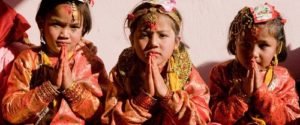By Arachika Kapoor —
Surrounded by the modern day houses and shops, exists the centuries-old ‘Kumari House’ in the royal palace of Basantapur Durbar Square in Kathmandu. The medieval structure houses ‘Kumari’ – Kathmandu’s ‘living goddess’, who is evoked in a young girl every morning.
Highlighting symbolism in Nepal’s Newar culture, two white stone lions stand to guard the door as we enter the Kumari House in Kathmandu’s Basantapur Durbar Square. In Nepal, these lions outside a building are first signs that the place holds an important status.
As we entered the building, a row of people stood in front of three slanted windows waiting for Kumari to come and bless them from there.
As the legend goes, ‘Kumari’ is an embodiment of goddess Taleju, who ruled the Kathmandu Valley from 12th till the mid-18th century. The kings of the Malla dynasty from the Kathmandu Valley were said to have a good relationship with goddess Taleju, and the goddess offered protection to the kingdom in return for the sincere worship she received.
The kings and the goddess together used to play Tripasa – a dice game, and during one such game, the last king of Kathmandu was said to have sexual thoughts about the goddess. It was then when she was outraged and punished the king, and left the kingdom unprotected.
After the king offered multiple rituals, the goddess relented. However, she did not go back to how things were. Instead, she offered to protect the kingdom manifesting her power through the body of a small girl who was to be established. This is how the tradition of royal Kumari came into effect.
The concept of having a protector deity is prevalent in the Newar settlements, and thus the Kumari House was built, which is one of the finest surviving examples of the Newar architecture.
For a girl to qualify as Kumari, she needs to belong to the 18 monasteries spread in Kathmandu, which means that her family must have kept the lineage pure and must not have married outside their caste for the last three generations. The girl must not have blemishes on her face, not have had major blood loss, should be pre-pubescent, and most importantly, her birth chart should match that of the country.
After candidates for being the royal Kumari are short-listed, each family is contacted to seek approval if they want their girl to be the next Kumari – Trishna Shakya, aged three, is the current Kumari, who was installed in September this year.
To evoke the goddess in the young girl, mantras and procedures have been passed on from generations to generations. Each morning, a Hindu and a Buddhist priest evoke goddess in her through tantric rituals, without which the little girl won’t become the goddess.
Decoding the myths
“There have been misconceptions about the Kumari going through a selection process where she is put in a room with buffalo heads or going through intimate physical examinations. On the contrary, the selection process is not cruel,” Sumana Shrestha, a social activist involved in the conservation of Nepali heritage, told India Outbound.
After a girl attains the status of the living goddess, she doesn’t live with her parents, until she hits puberty and another girl replaces her to become the new Kumari.
Though many think that only a pre-pubescent girl can be the Kumari because menstruation makes her impure, according to Shrestha, it is just because the power and energy of goddess flow in Kumari’s blood and thus after menstruation it is difficult to evoke the goddess in her because of blood loss. Moreover, a young girl is chosen over a mature woman because of her inherent purity.
Adapting to the changing times
In the earlier times, the living goddess had to frequently oblige her visitor’s call to bless them. Nowadays, since the society has become more aware of Kumari’s rights for education and personal space as a child, she is allowed to study.
And so, if you visit the Kumari House between 10:30-16:00 during the day, there are chances that she would be taking private lessons and might not appear in the window.
There are other 12 Kumaris in Kathmandu besides the one in Basantapur Durbar Square, and together they all form the Kumari worship customs.
It is worth an experience how people in Kathmandu have preserved the age-old tradition to date and the people strongly believe that goddess Taleju brings good luck and protects the city in the form of Kumari every day.
Courtesy : India Outbound / March 2018
Photo : Residence of Kumari at Kathmandu Durbar Square / Nepal Travel Biz News
March 11,2018
You might also wanna check Visit Nepal Year 2020 logo unveiled.




